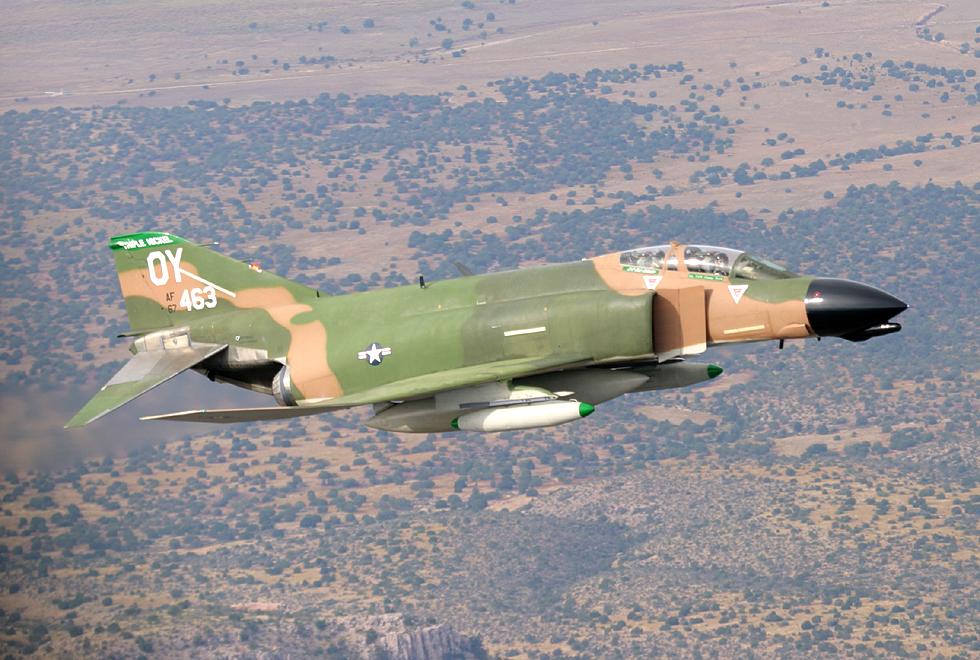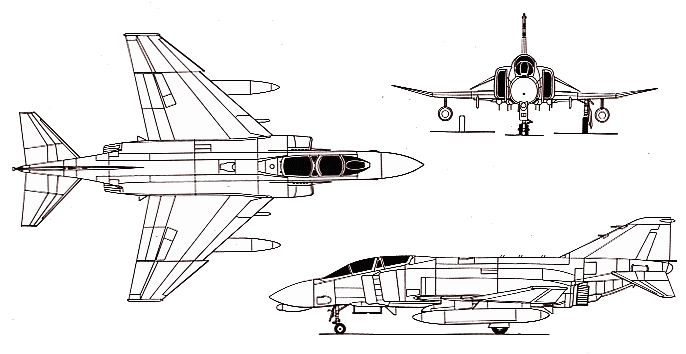McDonnell F-4D Phantom II






The F-4D was authorized in March of 1964, and the first example flew on December 7, 1965. Deliveries began in March of 1966. The first deliveries were to the 36th Tactical Fighter Wing based at Bitburg in Germany. It was later followed by the 4th TFW based at Seymour Johnson AFB in North Carolina in January of 1967. A total of 793 F-4Ds were built for the USAF.
The F-4D had the same engines and basic airframe as the F-4C, and had the same internal fuel tankage as that of the RF-4C. The major difference was in the avionics. The most significant change was the replacement of the APQ-100 radar of the F-4C by the smaller and lighter partly solid-state AN/APQ-109A. This was part of the AN/APA-165 radar set which introduced an air-to-ground ranging mode using movable cursors. The F-4Ds fitted with the AN/APQ-109A radar set could be externally distinguished from the F-4C by the presence of a larger radome.
The F-4D retained the AIM-7 Sparrow capability of the F-4C, but it deleted the Sidewinder capability on the inboard underwing pylon in favor of the Hughes AIM-4D Falcon infrared-homing missile. The AIM-4D (originally designated GAR-2B) had a launch weight of 134 pounds and had an maximum effective range of about 6 miles.
A multiple ejector rack was provided for the centerline pylon and triple ejector racks were provided for the inboard underwing pylon.
For weapons aiming, the F-4C had relied on a fixed sight and a simple chart on which it the image of the target was projected. The operation of this system made accurate bombing very difficult. The F-4D had improved avionics to increase the accuracy of its air-to-ground weapons. These included an AN/ASQ-91 weapons release computer system. This system measured various aircraft parameters such as speed, attitude, and climbing rate, and combined it with radar data on the slant range to the target to tell the bomb when to drop from the aircraft.
Also fitted was an AN/ASG-22 lead computing optical sight with amplifier and gyro. This system was designed to improve the effectiveness of the Phantom in air-to-air combat. The system combined information about speed, air density and angle of attack, and combined it with radar data about the velocity, direction and distance of the target to compute the lead angle needed to score a hit.
From the spring of 1967, the F-4D gradually began to replace the earlier F-4C in combat in Vietnam. It initially appeared over Vietnam with the 8th TFW, commanded by Lt.Col. Robin Olds. The first F-4D MiG "kill" took place on June 5, 1967, when crewmen Maj. Everett T. Raspberry and Capt. Francis Gullick shot down a MiG-17 near Hanoi. The F-4D eventually destroyed 45 enemy aircraft, and the USAF's 3 Vietnam-era aces got their fifth kills in F-4Ds during the Linebacker campaign of 1972. Captain Steve Ritchie of the 432nd TFW got his fifth kill in F-4D number 66-0167 on August 18, 1972.
In later years, the absence of an internal cannon was seen as a liability in close-in air-to-air combat. The F-4D could carry an external centerline SUU-23 pod containing an M-61A1 cannon, but it was bulky, provided lots of drag which seriously compromised performance, and was rather inaccurate to boot. In addition, the cannon pod took up valuable real estate underneath the fuselage, markedly reducing the offensive load that could be carried.
The Westinghouse AN/ASQ-152(V)-2 Pave Spike laser target designator was fitted to several F-4Ds. The cylindrical Pave Spike laser designator pod was mounted inside one of the Sparrow missile wells on the fuselage underside. The system used television optics, which made it daylight-capable only. Those Pave Spike aircraft which had the capability of launching the AGM-65 Maverick air-to-surface missile included 66-7509, 7531, 7546, 7634, 7661, 7722, 7746, 8819, and 8821.
AN/ARN-92 LORAN-D equipment was fitted to Pave Phantom F-4Ds. They could be identified by a rather prominent "towel-rail" antenna on the upper rear fuselage behind the rear cockpit. A total of 72 aircraft from blocks 32 and 33 were so equipped. In Vietnam, the primary mission of these Pave Phantom F-4Ds was the seeding of the Ho Chi Minh trail with sensors, which required the precise nighttime navigational capability provided by LORAN. The primary operators of the "towel-rail" F-4Ds were the 25th and 497th TFS of the 8th TFW and the 555th TFS of the 432nd TFW. Subsequently, these planes were passed along to the 457th TFS of the 301st TFW, the 23rd TFS of the 52nd TFW, and the 704th TFS of the 924th TFG.
In the early 1980s, F-4Ds began to reach Air Force Reserve units. The units obtaining the F-4D included: